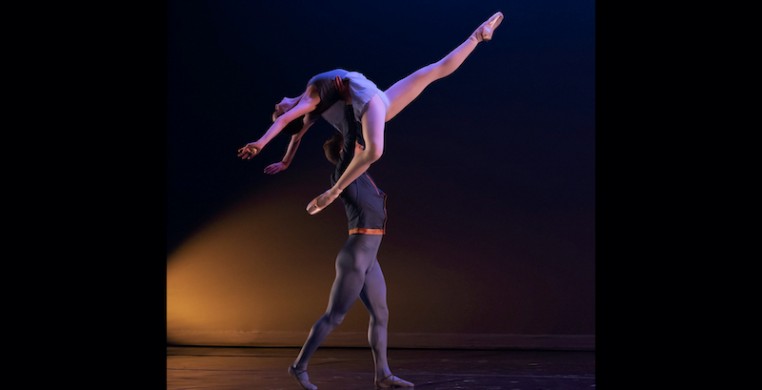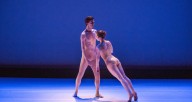“Refresh: A Digital Series” is a collection of curated works from Chicago Repertory Ballet that spans from the beginning of the company’s history up to present day, with a new dance film by artistic director Wade Schaaf. The program, streaming online through Sunday, features a selection of CRB favorites choreographed by a solid lineup of choreographers made up of Thodos Dance Chicago and Hubbard Street alumni. The works take place in familiar venues — like the Athenaeum Theatre, The Ruth Page Center for the Arts, the Vittum — and really gives you that “from the audience” feeling, complete with the occasional head-shaped silhouette of a person sitting in front of you, which I didn’t know I was nostalgic for, until I was.
The first number in the program, “Tree, Melody” (2019) by former Hubbard Street dancer Shannon Alvis has the intention of emulating a tree, whose branches are whipped with wind that is sometimes blustery and torrential. The shadow-casting rumples in the brown blouses worn by each dancer takes on the appearance of tree bark and it is easy to imagine sturdy branches swaying this way and that, hovering over a blue pool of light, like the sky reflected over water. Sometimes the wind catches one or two dancers like branches and sends them hurtling out towards the side, but as soon as the wind dies down, the tangle of limbs reaches out and rescues the stray branches from danger. In the second half, a piece of the tree—an acorn, perhaps—falls to the ground and struggles to root, jutting out its rhizomic tendrils in a desperate attempt at life. But not even the guiding embrace of Father Nature can save the acorn as it ultimately lies dormant, its life extinguished.
“Architecture: Splintered and Cracked” (2013), choreographed by veteran Chicago dancer and choreographer Jessica Miller Tomlinson, exhibits an adept control of using segregated lighting to build a scene and setting. A “wall of bodies” (as Tomlinson puts it) is isolated on the left side of the stage and seem to go through the motions of life—waking, sleeping, being intimate with one another—but under an oppressive filter that makes them appear jaunty and inanimate, like the Claymation monsters in old horror movies, with a Russian, neo-classical soundtrack that sounds like Stravinsky on steroids. While some of the people go along with the group, others try to break free, only to be reined in and re-absorbed into the collective. The dancers drag themselves to the other side of the stage, where a nefarious red hue encourages more extreme, undulating break-out attempts right before a bright, white light draws them all towards it, like souls transcending to an afterlife, or a prisoner emerging from underground confinement.
The third number in the program, “Them” (2021), is a new short dance film by Schaaf and features CRB company dancers Christopher Kelley, Akilah Harrison and Michael Erickson. “Them” is more of what I expected from a virtual dance show—one room, small cast, low production and heavy on the editing—but ended up exceeding my expectations through very subtle overlays of each dancer over the other, like ghosts occupying the same space at different times. A close-up of a hand gasping for another hand that is there, but not there, seems to articulate the experience that most dancers have had over the last year, having a dream of returning to normalcy that, right now, seems distant and ephemeral.
An unexpected treat can be found in “Strut!” (2021), another short dance film by Schaaf, which begins as a day-in-the-life of the young dancers in CRB’s Youth Performing Ensemble, but cleverly morphs into a legitimate music video set to the music of Sheena Easton. Standard black leotards and simple barre warm-ups transform into turquoise and magenta windbreakers and pointe shoe moonwalks. All I can really say about it is, “Bravo!”
Following a courteous three-minute intermission, another work by Schaaf, “Peoplescape: Juxtaposition” (2012), takes us from fluorescently lit dance studios and plunges us back into…dimness. “Peoplescape” succeeds in giving off a dark, creepy vibe as humanoids in beige leotards slingshot towards each other, under film noir-inspired shadowy lighting, but strain and claw to get away as soon as they make contact. The piece culminates in what can be described as a prolonged, inward contraction, that culminates in the dancers being drawn towards a bright, revelatory light. What takes the wind out of this piece for me is that it is too similar to both the first two works in the program: As in Alvis’ “Tree, Melody”, the costumes are a plain shade of brown, the lighting is dim and noir-ish and there are branches pushing and pulling away from each other. And in Tomlinson’s “Architecture,” there is again a “wall of bodies" secluded to one side of the stage or the other via oppressive lighting and it even ends with the dancers finding revelation in a bright, offstage light. Am I saying that this piece is ripping off the other two? Not according to the dates, but by this point in the program we have seen nearly this exact same idea presented in two works who offer a more refined version of the themes of isolation, introversion, desperation and escape.
The program grows even darker with “It’s Not Enough to Close Your Eyes,” by former Thodos Dance Chicago performer Jacqueline Stewart. This piece features a duet set strictly against a single, powerful light on the floor, again with dancers embracing, grappling and reaching out, this time towards the light which they must not touch, sometimes, for reasons not explained. The effective use of light creates static moments of stark, washed-out brightness, like a picture taken using an old-timey flash camera, while leaving limbs and faces lost, shrouded in darkness.
And then my prayers were answered by another work of Schaaf’s, “Grand Pianola Music: On the Dominant Divide,” (2019) which reminds us that, oh yeah, there’s “ballet” in CRB’s name. That is not a dig. CRB’s mission statement clearly reads that they are in the business of “challenging preconceived notions of the art-form” of ballet, and I admit that, at this point in the program, I did not expect a grand, classical production number. “Grand Pianola Music” is like three ballet finales compressed into one: The rising curtain reveals a scene already in pandemonium with divergent groups of three or four dancers rocketing across the stage as living statues are hoisted in the air at seemingly random moments, like fireworks set to music. It’s a fantastic number and I could have used more like it, though maybe with less going on, to break up the dark nature of the other staged works in this program.
It may seem odd to label a show that is mostly throwback pieces “Refresh,” but it is refreshing to feel like an audience member again as opposed to a disembodied consciousness floating around and through the dancers, as is becoming more common when viewing virtual works. “Refresh” reflects the darkness that we currently feel in isolation, but also shines a light on an optimistic future while assuring us that the past is still vibrant, if not ghostly and ephemeral, in our memories.
--
Chicago Repertory Ballet's "Refresh" continues online through Sunday. Tickets are $20, with hot deals available by clicking the event page below.


